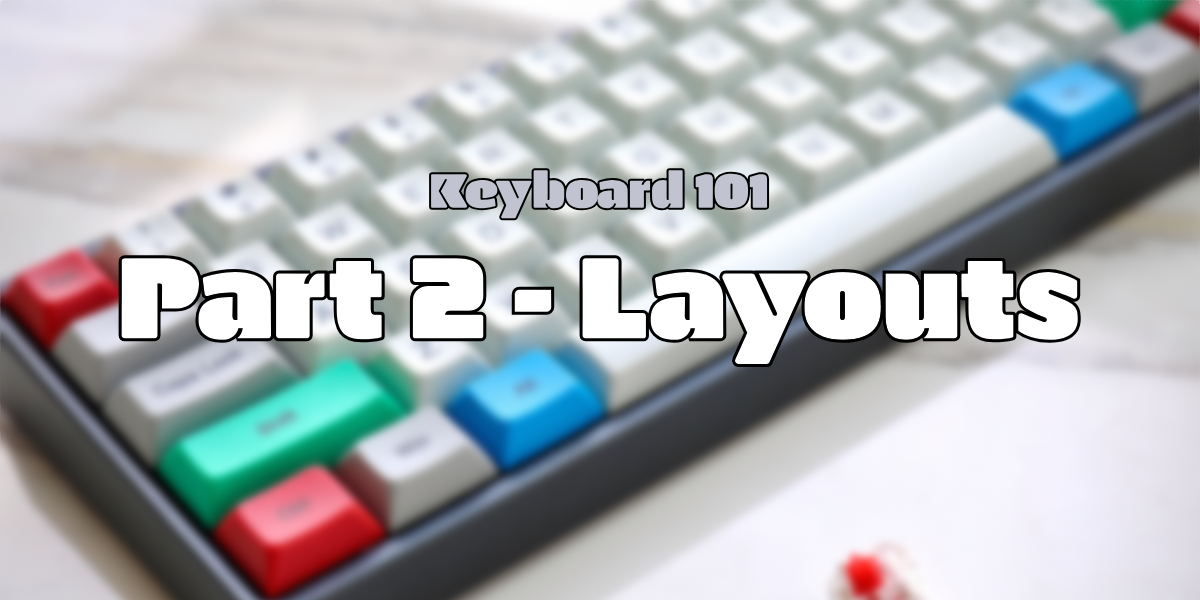Keyboard 101 - Part 2: Layouts

In this post, we’ll talk about layouts, meaning:
- how the keys are laid on the keyboard
- how the keys are laid out between one another
- how many keys are on the keyboard
- …
Hang on, this will be a bit long. But always bare in mind the idea is to improve the ergonomics of a tool we use daily!
To illustrate this post, some links will redirect you towards online shops. Those links are not affiliated. Moreover, I did not personally test each and every showcased keyboard, I mostly found them to prove they exists.
Staggered or ortholinear keyboard?⌗
Before even looking at the number of keys, you must know the distinction between 2 families of keyboards. The vast majority of keyboards is staggered. If you never heard about it, chances are you have one of this kind. In opposition, you have the ortholinear ones, whose keys are aligned on a grid.
I might as well tell you right now, this vast majority (so, staggered) is an ergonomic horrorshow. Look at your fingers for 2secs. Are they staggered as you keys, or are they straight, suitable to fit on a grid? This is to answer to this ergonomic issue that ortholinear keyboards were made. They fit your fingers, and minimize the travel time between each key. With such keyboards, no more finger wrapping to change line! That said, why are we seeing so much staggered keyboard? For historical reasons, sadly.

Typewriter is the ancestor of keyboard. At that time, it came with specific constraints. To type a character, you press a key which will lift a “punching bar”, which will in turn punch the paper at the exact center of the writing area. The paper is moving, not the typing area.
This simple (but clever!) mechanical solution needs a lever linked to each key and punch bar. In order to simplify the mechanism, we just…staggered the keys so the lever can pass through. Et voilà!
With technical progress, mechanical typewriter were gradually being replaced by electrical ones, then teletypewriters, and then our keyboards… Without ever wondering if we could improve a system based on constraints that no longer exist.
Classical or split keyboard?⌗
Obviously, at the time of typewriters, we pursued something more compact, so we reduced the area of the keyboards. However this results in keyboards that are mostly narrower than shoulder width (well, excluding numpads): when typing on one, the shoulders and torso are clenched, leading to muscle tensions on long-term.
That’s why some thought to themselves “to open the shoulders, why won’t we cut the keyboard in two halves?” That way, each half can be spread as far apart as one need. And thus split keyboards were born.

Disconcerting at first, it takes some time getting used to typing well with both hands. But once this (small) difficulty is overcome, the comfort of the position is an unequalled benefit.
Keyboards sizes⌗
Well, I guess you got my point, I’m an advocate for ortholinear keyboards 😄 however staggered are still more common, and so are the standardized sizes. We’ll see some ortho at the end, but for now let’s dive into the classical ones.
In the following diagrams, the last line has been deliberately left “blank”, as it is the one that will most likely change, between Windows and Mac, with or without the fn key, etc. The chosen format is also the ANSI format, which is recognizable by its large Shift key and small Enter key. This is opposite to the ISO format, but I won’t go into that here (one have to know where to draw the line!). If you want to know more, see ANSI vs ISO.
100%⌗
The most complete size. Every possible key, but are they all needed? With such a keyboard, no need for another macropad. Function row? Granted. Numpad? Obviously! Navigation keys (page up, page down,…)? Well why not!
Examples: Razer Deathstalker V2 Pro, WASD V3 104-key custom mechanical keyboard
80% (TKL, Ten Key Less)⌗
One of the most popular formats of the moment. For those who want a more compact keyboard without sacrificing the navigation keys and the function row. You can always add an external number pad if needed 😉
Examples: Ducky One 3 RGB TKL, MSI VIGOR GK50
75%⌗
A format quite similar to TKL (80%), but with less wasted space on the top line and a compacted navigation area on the rightmost column.
Examples: Logitech Pop Keys, Keychron Q1
65%⌗
Like the 75%, but who really needs the function row? 😄
Examples: RK68, ROG Falchion
60%⌗
A keyboard suitable for typing text. All extraneous functions are removed.
Examples: K70 Pro Mini Wireless, SK621
40%⌗
Well, this one is extreme, just for fun (and to show you that there are many more)
Examples: Vortex Core, Drop OKLB
2%⌗
Are there still too many keys on the 40% for your taste? Beware, the keyboard community can go even lower. Ladies and gentlemen, please welcome… The Milk 2%
Honorable mention for ortholinear keyboards⌗
In general, ortholinear keyboards are about ergonomics (remember, staggered rely on obsolete constraints), there are no really standards as before. Moreover, when it comes to ergonomics, it is not uncommon to find splits, like the ErgoDox EZ.

Or we can talk about the Planck
Or even, the TypeMatrix

In conclusion, the perfect keyboard? Ortholinear, split, 75% with a Dvorak layout… Just kidding 😄 The perfect keyboard depends on your use, obviously! Everyone will have different needs and desires, but remember that the “classic” keyboards you know are far from being the best keyboards. The manufacturers are still following a path that was started more than a century ago… Just because many are wrong doesn’t mean they are right 😉
Ressources⌗
To go further, here’s a list of articles that helped me writing this one
- ANSI vs ISO by Jake Harfield
- Typing Through Time: Keyboard History by DasKeyboard